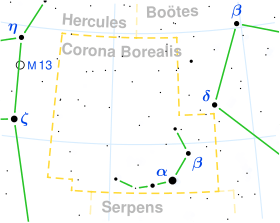Zeta Coronae Borealis
 | |
| Observation data Epoch J2000.0 Equinox J2000.0 (ICRS) | |
|---|---|
| Constellation | Corona Borealis |
| ζ1 | |
| Right ascension | 15h 39m 22.247s[1] |
| Declination | +36° 38′ 12.42″[1] |
| Apparent magnitude (V) | 4.99[2] |
| ζ2 | |
| Right ascension | 15h 39m 22.668s[1] |
| Declination | +36° 38′ 08.78″[1] |
| Apparent magnitude (V) | 5.95[2] |
| Characteristics | |
| ζ1 | |
| Evolutionary stage | Main sequence |
| Spectral type | B6 V + B7 V[2] |
| ζ2 | |
| Evolutionary stage | Main sequence |
| Spectral type | B9 V[2] |
| Astrometry | |
| Proper motion (μ) | RA: −14.82[3] mas/yr Dec.: −4.74[3] mas/yr |
| Parallax (π) | 6.89[3] mas |
| ζ1 | |
| Radial velocity (Rv) | −19.4[4] km/s |
| ζ2 | |
| Radial velocity (Rv) | −24.3[4] km/s |
| Orbit[5] | |
| Primary | ζ2A |
| Companion | ζ2 B |
| Period (P) | 1.72357 |
| Eccentricity (e) | 0.013 |
| Inclination (i) | 38° |
| Semi-amplitude (K1) (primary) | 109.6 km/s |
| Semi-amplitude (K2) (secondary) | 121.2 km/s |
| Orbit | |
| Primary | ζ2 AB |
| Companion | ζ2 C |
| Period (P) | 251.5 |
| Eccentricity (e) | 0.48 |
| Semi-amplitude (K1) (primary) | 28.5 km/s |
| Details[6] | |
| ζ2 A | |
| Mass | 4.13 M☉ |
| Rotation | 1.7 days |
| Rotational velocity (v sin i) | 46 ± 7 km/s |
| ζ2 B | |
| Mass | 3.73 M☉ |
| Rotational velocity (v sin i) | 7.5 ± 2 km/s |
| ζ2 C | |
| Mass | 3.78 M☉ |
| Other designations | |
| ζ1: HR 5833, HD 139891 | |
| ζ2: HR 5834, HD 139892 | |
| Database references | |
| SIMBAD | ζ |
| ζ1 | |
| ζ2 | |
ζ Coronae Borealis , Latinised as Zeta Coronae Borealis, is the Bayer designation of a double star in the constellation Corona Borealis. The two components are separated by six arc-seconds and share the same Hipparcos catalogue number and Flamsteed designation. The brighter star, ζ2 Coronae Borealis, is itself a probable spectroscopic triple system.
References
- 1 2 3 4 Cutri, R. M.; Skrutskie, M. F.; Van Dyk, S.; Beichman, C. A.; Carpenter, J. M.; Chester, T.; Cambresy, L.; Evans, T.; Fowler, J.; Gizis, J.; Howard, E.; Huchra, J.; Jarrett, T.; Kopan, E. L.; Kirkpatrick, J. D.; Light, R. M.; Marsh, K. A.; McCallon, H.; Schneider, S.; Stiening, R.; Sykes, M.; Weinberg, M.; Wheaton, W. A.; Wheelock, S.; Zacarias, N. (2003). "VizieR Online Data Catalog: 2MASS All-Sky Catalog of Point Sources (Cutri+ 2003)". VizieR On-line Data Catalog: II/246. Originally published in: 2003yCat.2246....0C. 2246. Bibcode:2003yCat.2246....0C.
- 1 2 3 4 Eggleton, P. P.; Tokovinin, A. A. (2008). "A catalogue of multiplicity among bright stellar systems". Monthly Notices of the Royal Astronomical Society. 389 (2): 869. arXiv:0806.2878. Bibcode:2008MNRAS.389..869E. doi:10.1111/j.1365-2966.2008.13596.x.
- 1 2 3 Van Leeuwen, F. (2007). "Validation of the new Hipparcos reduction". Astronomy and Astrophysics. 474 (2): 653. arXiv:0708.1752. Bibcode:2007A&A...474..653V. doi:10.1051/0004-6361:20078357.
- 1 2 Wilson, Ralph Elmer (1953). "General catalogue of stellar radial velocities". Washington. Bibcode:1953GCRV..C......0W.
- ↑ Gordon, K. D.; Mulliss, C. L. (1997). "Zeta$^2$ Coronae Borealis, A Spectroscopic Triple System Including an Asynchronous Close Binary". Publications of the Astronomical Society of the Pacific. 109: 221. arXiv:astro-ph/9611090. Bibcode:1997PASP..109..221G. doi:10.1086/133877.
- ↑ Tokovinin, A. (2008). "Comparative statistics and origin of triple and quadruple stars". Monthly Notices of the Royal Astronomical Society. 389 (2): 925. arXiv:0806.3263. Bibcode:2008MNRAS.389..925T. doi:10.1111/j.1365-2966.2008.13613.x.
This article is issued from
Wikipedia.
The text is licensed under Creative Commons - Attribution - Sharealike.
Additional terms may apply for the media files.